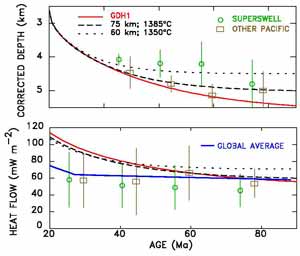|
Why
is heat flow not high at hotspots?
|
A peculiar aspect of hotspots is that heat flow data provide no evidence
for their being hotter than lithosphere of the same
age elsewhere. Originally, the uplift at Hawaii and
similar midplate hotspots was thought to reflect a
hot plume causing heating to about 50 km of the surface
[Crough, 1983; McNutt and Judge,
1990]. Such heating predicts heat flow significantly
higher than from the usual cooling of oceanic lithosphere
as it spreads away from the mid-ocean ridges where
it formed. Although anomalously high heat flow was
initially reported, subsequent analysis showed that
most, if not all, of the apparent anomalies resulted
from comparing data to thermal models that underestimated
heat flow elsewhere.
Figure 1 illustrates this for the Hawaiian swell,
the largest and best-studied hot spot swell. Heat
flow on the swell was originally thought to be anomalously
high relative to the predictions of the a thermal
model by Parsons & Sclater [1977] (PSM).
This was consistent with the elevated heat flow expected
for the lithosphere being thinned and heated [von
Herzen et al., 1982]. A subsequent transect across
the swell showed that the heat flow differs at most
slightly from that for lithosphere of comparable ages
[von Herzen et al., 1989]. Thus much of the
apparent anomaly resulted from comparing the heat
flow to PSM, which systematically underpredicts the
heat flow and overpredicts the depths for old lithosphere
such as that near Hawaii, where the crust is 100 Myr
old.
|
Figure 1. Heat flow along (lower left) and
across (lower right) the Hawaiian Swell. Heat flow, though anomalously
high
with
respect to
the PSM model, is at most slightly above that expected for GDH1
[Stein and Stein, 1993]. Bathymetry across the swell along the
heat flow line compared to GDH1 and PSM model predictions
(upper right). |
A different picture
emerges from comparison of the data to model GDH1,
which fits the depth and heat flow data significantly
better, especially for older lithosphere [Stein
and Stein, 1992]. The swell heat flow is
at most slightly above that expected for GDH1,
leaving no significant anomaly. The situation
is similar for the Bermuda, Cape Verde, and Crozet
hot spots.
Similarly, heat flow is not unusually
high for the Superswell region of the Pacific,
which is substantially shallower than expected
for its age. Although the shallow bathymetry is
consistent with the plate being thermally thickened
[McNutt & Judge, 1990], heat flow
(Figure 2) does not differ from that for lithosphere
of the same age elsewhere in the Pacific [Stein
& Abbott, 1991] or a global average [Stein
et al., 1995]. |

Figure 2. Depth (top), and heat flow (bottom) for the Superswell
and lithosphere of the same age elsewhere in the Pacific, averaged
in 20-Myr bins. Closed & open symbols: means & medians. Although
the Superswell is shallow, consistent with lithospheric heating model
predictions (dashed), heat flow is similar to the global average & the
rest of the Pacific [updated from Stein and Stein, 1993]. |
Subsequent plume models have generally assumed that the uplift results
from the dynamic effects of rising plumes [Liu
and Chase, 1989; Sleep, 1994] and the
associated compositional buoyancy. The thermal effects
of these are postulated to be concentrated at the
base of the lithosphere and thus to raise surface
heat flow at most slightly, because tens of millions
of years are required for heat conduction to the surface.
An alternative model is that the uplift results from
excess magma production rather than high temperatures,
as proposed by Foulger
[2002] for Iceland. In the case of that model,
no heat flow anomaly is expected.
-
-
Crough, S.T., Hotspot swells, Annual Review
of Earth and Planetary Sciences, 11, 165-193,
1983.
-
-
Liu, M., and C.G. Chase, Evolution of midplate
hotspot swells - numerical solutions, J. geophys. Res., 94,
5571-5584, 1989.
-
McNutt, M.K., and A.V. Judge, The superswell and
mantle dynamics beneath the south Pacific, Science, 248,
969-975, 1990.
-
Parsons, B., and J.G. Sclater, An analysis of the
variation of ocean floor bathymetry and heat flow with age J.
geophys. Res., 82, 803-827, 1977.
-
Sleep, N.H., Lithospheric thinning by midplate
mantle plumes and the thermal history of hot plume material ponded
at sublithospheric depths, J. geophys. Res., 99,
9327-9343, 1994.
-
Stein, C., and D. Abbott, Heat-flow constraints
on the south-Pacific superswell, J. geophys. Res., 96,
16,083-16,100, 1991.
-
Stein, C.A., S. Stein, and A. Pelayo, Heat flow
and hydrothermal circulation, in Physical, chemical, biological
and geological interactions within hydrothermal systems, Am.
Geophys. Un., Washington, D.C., 1995.
-
Stein, C.A., and S. Stein, A model for the global
variation in oceanic depth and heat-flow with lithospheric age, Nature,
359, 123-129, 1992.
-
Stein, C.A., and S. Stein, Constraints on Pacific
midplate swells from global depth-age and heat flow-age models, in
The Mesozoic Pacific: Geology, Tectonics, and Volcanism,
pp. 53-76, American Geophysical Union, Washington, D.C., 1993.
-
von Herzen, R.P., M.J. Cordery, R.S. Detrick, and
C. Fang, Heat-flow and the thermal origin of hot spot swells - the
hawaiian swell revisited, J. geophys. Res., 94,
13,783-13,799, 1989.
-
von Herzen, R.P., R.S. Detrick, S.T. Crough, D.
Epp, and U. Fehn, Thermal origin of the Hawaiin swell - heat-flow
evidence and thermal models, J. geophys. Res., 87,
6711-6723, 1982.
Additional key references on heatflow
- Kaula, W.M., Minimal upper mantle temperature variations consistent
with observed heat flow and plate velocities, J. Geophys. Res.,
88, 10,323-10,332, 1983.
- Kaula, W.M., Material properties for mantle convection consistent
with observed surface fields, J. Geophys. Res., 85,
7031-7044, 1980.
last updated February, 2005 |
